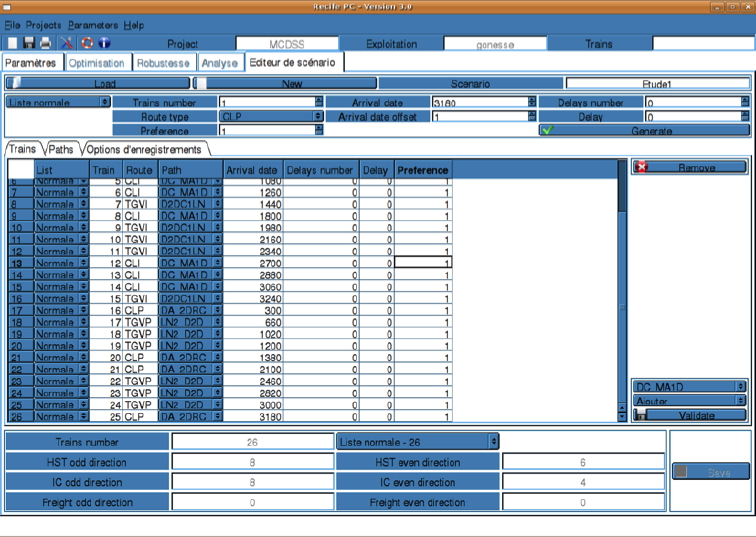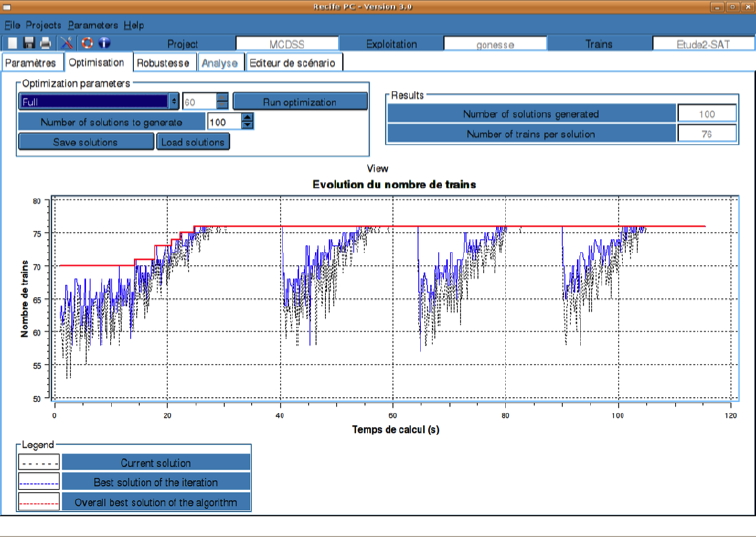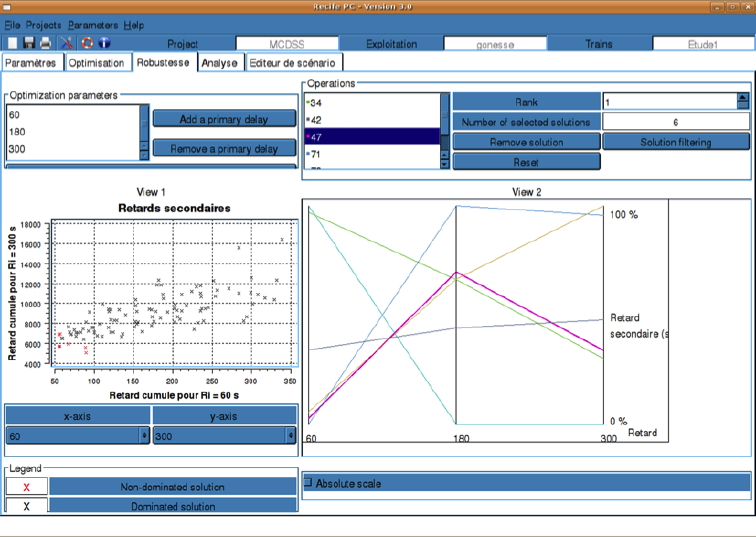[
Home
| Top ][ Motivation
| Principle | Software
| References | Contacts
| Acknowledgment ]
Motivation
[ Home | Top ][ Motivation | Principle | Software | References | Contacts | Acknowledgment ]The development and the success of high speed trains, conjugated with the saturation of roads in and around large cities, are two factors boosting the renewed interest for the railway transportation. Additionally, the many advantages of train for sustainable development favors the railway companies. Consequently the rail traffic is continuously increasing those last years in Europe. However to remain competitive, the railway companies have to improve efficiency and quality of service offered to the customers: more trains in operation, less trains delayed.
As in many European countries, the French railways have been separated into train operation and railway infrastructure. RFF is the French railway infrastructure manager, while the SNCF is the historical operator with the dominant market share position in the passenger and freight railway transportation. Soon, new private and possibly low-cost operators may appear on this market. They could operate on some lines, introducing changes in passenger transportation.
Freight transportation is also concerned. To reduce the number of trucks on the roads, the rail freight operators must offer a comparable quality of service (punctuality, reliability, flexibility, average commercial speed...) in order to increase the number of trains in operation. Consequently, a passenger or a freight train running on an infrastructure will be subject the payment of a track access charge to the infrastructure manager.
In order to implement a rail transport supply strategy, it is crucial to have operational tools for supporting the studies and the analysis of railway infrastructure development strategies. For example, tools must be able to identify the limits of an existing or future network, with one or more possible supply configurations. The central challenge for an optimal use of the infrastructure requests an appropriate measure of the railway infrastructure capacity.
Principle
RECIFE is a Multi
Criteria
Decision Support Software including models
and
algorithms to evaluate railway infrastructure capacity.
It
helps decision-maker expert
in
railway transportation to optimize the use of
the infrastructure at a microscopic level. It
considers a feasibility or
saturation problem and the stability of
proposed timetables.
RECIFE uses Multi Criteria Decision Making
methodologies within models, algorithms, and functionalities. It
is now
fully operational and has been implemented at the
Pierrefitte-Gonesse
junction and the Lille-Flandres station in order to validate the
principles and the proposed algorithms in real
complex railway (junction or
station) environments. The core of the decision process
in
RECIFE integrates two models.
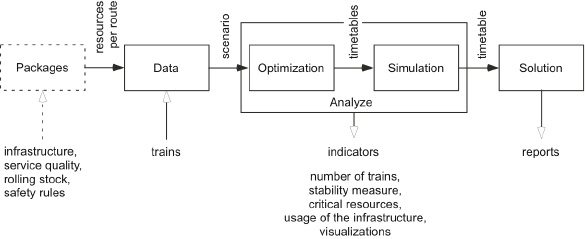
The optimization
model aims
to maximize the number of train,
i.e. to optimize the timetable's feasibility and saturation
objectives,
as well as the objective representing DM
preferences. The model to solve is then optimized with an
algorithm
based on the principle of metaheuristics. It returns a
collection of
equivalent solutions on the number of trains
scheduled.
Two
equivalent solutions have timetables with the same number of
trains,
but with different types and/or schedules.
The simulation model
maximizes the stability of equivalent solutions (minimize the
sum of
delays). In order to assess the
stability, several objectives are "dynamically" defined by the
DM in
order to simulate the effect of delays on solutions. The DM is
focused
on the efficient solutions who are representative of the best
compromises. Analysis tools provided helps the DM to
choose one timetable among the
efficient solutions highlighted by the software.
Software
Input data, one
scenario:
The DM defines the list of trains who are candidate to be
scheduled in a timetable and their characteristics (arrival
date,
authorized delay, authorized routes, preferences...). On the
left
part of this figure, 26 passengers trains are candidates for
crossing a
junction.
First stage, the
optimization
activity:
The DM is informed by the convergence of the optimization
algorithm. The figure is a screenshot of the optimization
screen: X
axis denotes the elapsed time, Y axis the number of trains
scheduled in
the solutions. The oscillation results from the restart
strategy
included in the algorithm. No improvement is obtained after
the first
restart for this example.
Second stage, the
simulation
activity:
Visual tools based on MCDM concepts are provided to the DM
for supporting its analysis of solutions. The figure is a
screenshot of
the simulation screen. Three primary delays (60, 180, 300
seconds)
are defined. DM analyzes the corresponding secondary delays in
a two
dimensional flat view showing all the equivalent timetables
(view 1,
left).
With the current options, 6 timetables are efficients. Their
profiles
are shown for
the 3 objectives (60, 180, 300) (view 2, right). DM is
focusing on
solution number 47 which is highlighted on views.
Data in output, a robust
feasible
timetable:
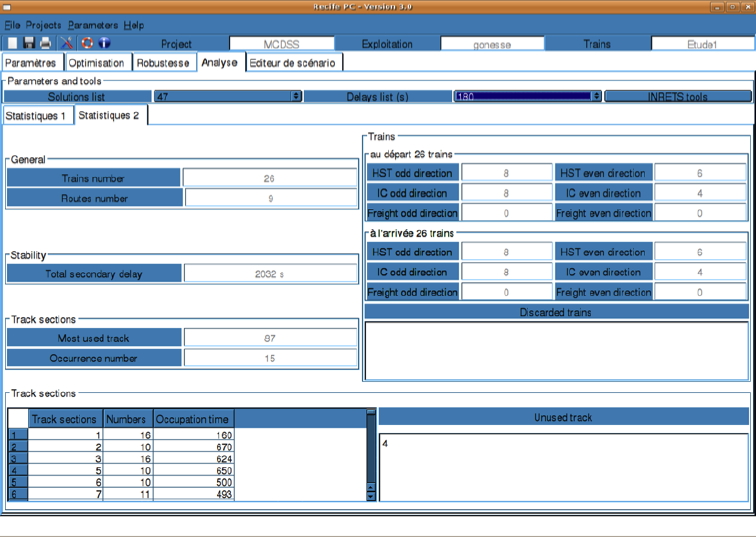
Macroscopic and microscopic quantitative information about
a
solution are available for supporting the analyze. Here all
the 26
trains are scheduled, using 9 routes. The detail by type of
train is
also reported (right top). For this solution, 15 trains are
using the
track 87 appearing as the most often requested part of the
infrastructure. The most busy track sections are also reported
in term
of occupation time (left bottom). Only the track section 4 is
unused
(right bottom) by the solution. For this solution, a primary
delay of
180 seconds generates a secondary delay of 2032 seconds.
Analyse tool 1, space-time
diagram:
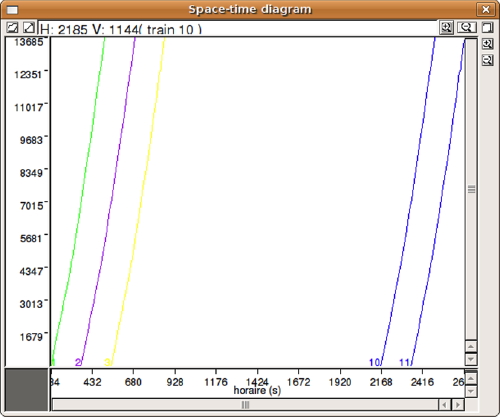
This is the common view representing a solution, where X is
the
time, Y the distance. Here 5 trains are scheduled on this
route
Analyse tool 2, Gantt
chart
timetable visualization:
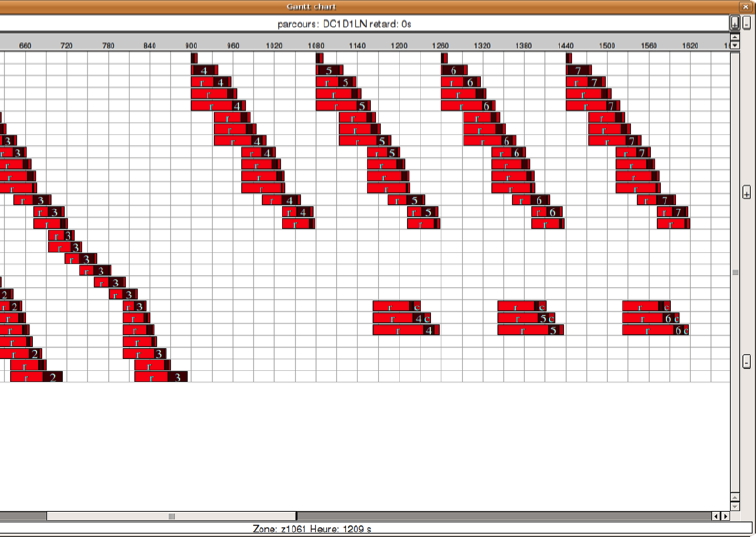
This view allows a detailed examination of the resources
used by each train included in
a solution.
Analyse tool 3, Track
layout
timetable animation:
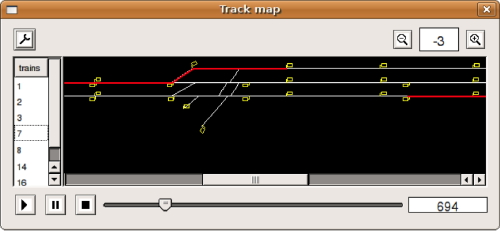
Any solution can be played allowing the DM to track a particular train. Here the train 7 is monitored by the DM.
References
[ Home | Top ][ Motivation | Principle | Software | References | Contacts | Acknowledgment ]Degoutin, Fabien, Rodriguez, Joaquin, and Gandibleux, Xavier. 2005. Première évaluation des performances d'un modèle CSP pour le problème de saturation d'infrastructures ferroviaires. In Proceedings of the ROADEF 2005 - French National OR Conference (J.-Ch. Billaut et C. Esswein Coord.) Collection Sciences, Technologie "Informatique". Presses Universitaires François Rabelais. Pages 277-294. ISBN :2-86906-196-X. (In french).
Degoutin, Fabien. 2007. Modélisation par contraintes et heuristiques pour l'évaluation de la capacité d'infrastructures ferroviaires. PhD thesis, Université de Valenciennes et du Hainaut Cambrésis, Valenciennes, France. (In french).
Delorme, Xavier, Rodriguez, Joaquin, and Gandibleux, Xavier. 2001. Heuristics for railway infrastructure saturation. Electronic Notes in Theoretical Computer Science series, volume 50 of issue 1, 15 pages. Elsevier.
Delorme, Xavier. 2003. Modélisation et résolution de problèmes liés à l'exploitation d'infrastructures ferroviaires. PhD thesis, Université de Valenciennes et du Hainaut Cambrésis, Valenciennes, France. (In french).
Delorme, Xavier, Gandibleux, Xavier, and Degoutin, Fabien. 2010. Evolutionary, constructive and hybrid procedures for the bi-objective set packing problem. European Journal of Operational Research, 204(2):206-217.
Delorme, Xavier, Gandibleux, Xavier, and Rodriguez, Joaquin. 2004. GRASP for set packing problems. European Journal of Operational Research, 153 (3), 564-580.
Delorme, Xavier, Gandibleux, Xavier, and Rodriguez, Joaquin. 2009. Stability evaluation of a railway timetable at station level. European Journal of Operational Research, 195(3), 780-790.
Ehrgott, Matthias, and Gandibleux, Xavier. 2004. Approximative Solution Methods for Multiobjective Combinatorial Optimization. TOP: International Journal on Operations Research of the Spanish Society of Statistics and Operations Research, 12(1), 1-63. Springer.
Gandibleux, Xavier, Delorme, Xavier, and T'Kindt, Vincent. 2004. An Ant Colony Algorithm for the Set Packing Problem. In Ant Colony Optimization and Swarm Intelligence (Dorigo, M., Birattari, M., Blum, Ch., Gambardella, L., Mondada, Fr., & Stutzle, Th. eds). Lecture Notes in Computer Sciences, vol. 3172, pages 49-60. Springer.
Gandibleux, Xavier, Jorge, Julien, Delorme, Xavier, and Rodriguez, Joaquin. 2010. Algorithme de fourmis pour mesurer et optimiser la capacité d'un réseau ferroviaire. In Fourmis artificielles 1; des bases de l'optimisation aux applications industrielles (N. Monmarché, F. Guinand, et P. Siarry eds). Chapitre 9, pages 211-240. Traité IC2. Hermès-Lavoisier. (In french).
Gandibleux, Xavier, Riteau, Pierre, and Delorme, Xavier. 2010. RECIFE: a MCDSS for railway capacity. In Multiple Criteria Decision Making for Sustainable Energy and Transportation Systems (Ehrgott, M., Naujoks, B., Stewart, Th., & Wallenius, J. eds). Lecture Notes in Economics and Mathematical Systems, vol. 634. Pages 93-103. Springer.
Mérel, Aurélien, Gandibleux, Xavier, Demassey, Sophie, and Lusby, Richard. 2009. An improved Upper Bound for the Railway Infrastructure Capacity Problem on the Pierrefitte-Gonesse Junction. In Proceedings of the ROADEF 2009 - French National OR Conference. Pages 62-76. ISBN :2-905267-64-X.
Rodriguez, Joaquin, Delorme, Xavier, and Gandibleux, Xavier. 2002. Railway infrastructure saturation using constraint programming approach. In Computers in railways VIII (J. Allan, R. Hill, C. Brebbia, G. Sciutto, and S. Sone, eds), pages 807-816, Southampton. WIT press.
Rodriguez, Joaquin, Delorme, Xavier, Gandibleux, Xavier, Marlière, Grégory, Bartusiak, Roman, Degoutin, Fabien, and Sobieraj, Sonia. 2007. RECIFE: models and tools for analyzing rail capacity. Recherche Transports Sécurité, 95, 19-36.
Contacts
[ Home | Top ][ Motivation | Principle | Software | References | Contacts | Acknowledgment ]Xavier Gandibleux ( Xavier[dot]Gandibleux[at]univ-nantes[dot]fr ).
Département d'informatique, Université de Nantes
2 rue de la Houssinière BP 92208, F44322 Nantes Cedex 03 - FRANCE.
Xavier Delorme (Delorme[at]emse[dot]fr).
Centre Génie Industriel et Informatique, Ecole Nationale Supérieure des Mines de Saint-Etienne
158 cours Fauriel, F42023 Saint-Etienne Cedex 2 - FRANCE.
Joaquin Rodriguez (Joaquin[dot]Rodriguez[at]inrets[dot]fr).
INRETS-ESTAS, Université Lille-Nord de France
20 rue Elisée Reclus, BP 317, F59666 Villeneuve d'Ascq Cedex - FRANCE.
Acknowledgment
RECIFE is partially issued from the research project "REcherches en Capacité d'Infrastructures FErroviaires" (i.e. railway infrastructure capacity studies) involving INRETS (the French national institute for transport and safety research), SNCF (the French national railway company), University of Valenciennes, Ecole des Mines de Saint-Etienne and University of Nantes. The research project has been partially supported by the regional council Nord-Pas de Calais and European Union research funds (FEDER).
Crédits photos: RFF

